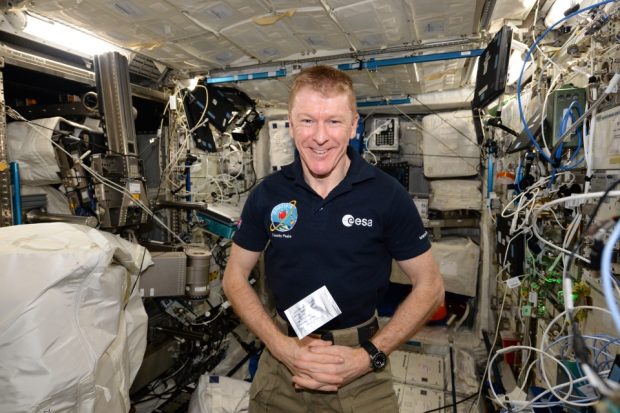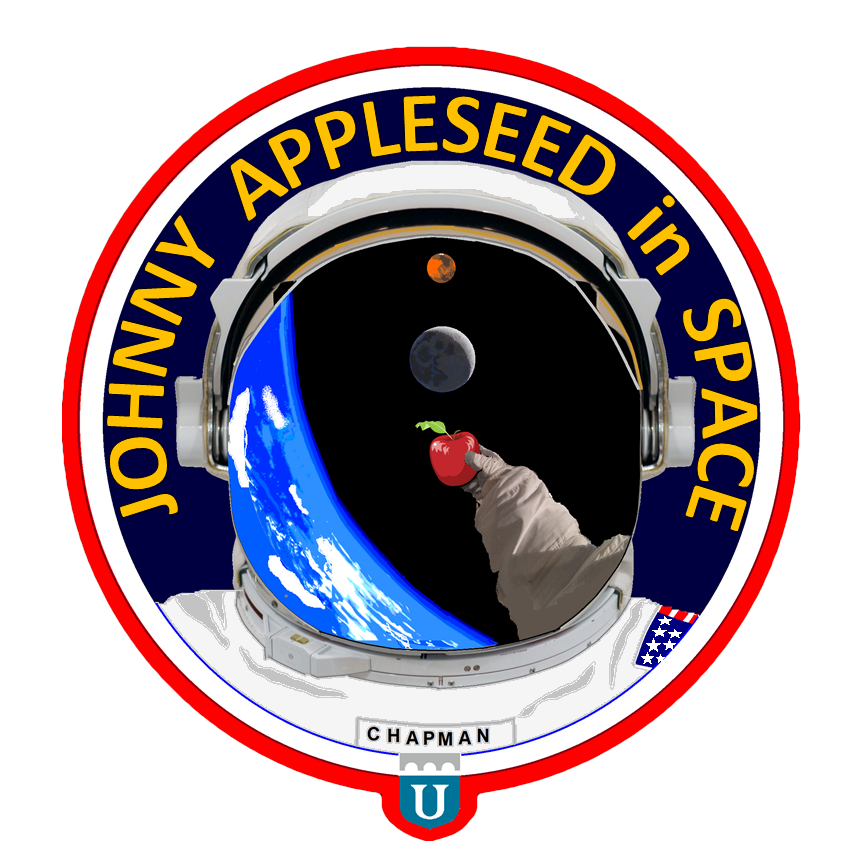John Chapman was an American hero, introducing apple trees across Pennsylvania, Ohio, Indiana, Illinois, Ontario, and what is now West Virginia. While it’s charming to imagine him as randomly sowing apple seeds wherever he went, in truth he was more methodical. He planted nurseries of young trees, fenced them off and left them in someone’s care, returning every so often to tend to the trees. But as the legendary Johnny Appleseed, he is a true hero of the pioneer age.
As we look ahead to becoming a multi-planetary species, it seems likely that we’ll want to take our apples with us as we spread out from Earth. But so far, the apple has only taken a few small steps towards the final frontier.
Newton’s Apple
An apple tree has a very special place in space history, entwined with Newton’s discovery of the laws of gravity. The idea that an apple falling caused Newton’s “a-ha” moment is a memorable exaggeration, but he himself credited the tree with sowing the seeds of his new theory. Now around 400 years old, that tree still exists at Newton’s former home – Woolsthorpe Manor in Lincolnshire.
Fittingly, the first apple pips to travel into space were from Newton’s apple tree. Supplied by the National Fruit Collection at Brogdale in Kent, they flew on Apollo 10 with John Young, Thomas Stafford and Gene Cernan, orbiting the Moon in May 1969. Apollo 10 was the “dress rehearsal” for the Moon landing, doing everything but land on the Moon. A letter signed by the three astronauts confirms that the apple seeds stayed in the Command Module, nicknamed Charlie Brown.

The letter is addressed to Philip M Mikoda in Windsor, New York. He was associated with Peacock Hill, an exotic bird farm. It looks as though Mikoda arranged the launch of the seeds, which explains why the package also contained peacock feathers. Mikoda later wrote to Brogdale, stating that the seeds had begun to germinate once they returned to Earth. He wanted more pips to send on Apollo 11, but it’s surprisingly difficult to find any more details.
Alan’s Apple?
Interestingly the US National Plant Germplasm System has a record for a variety of apple called ‘Bean’. It notes that the variety is a cross between ‘Golden Delicious’ and ‘Flower of Kent’ (Newton’s apple tree is a Flower of Kent) and that its seeds supposedly flew to the Moon with Alan Bean on Apollo 12. However, I can’t find any corroborating data to suggest that’s true. Roger D. Way of Cornell University donated the ‘Bean’ sample in January 1986. He was a world-renowned pomologist and apple breeder and died at the ripe old age of 100 in June 2019. Even if it is true that the Bean apple has been to the Moon, it’s unlikely ever to be popular. The USDA website describes it as small, acidic, and worthless.
Apple wood flies in space
Newton’s apple has remained a source of inspiration to spacefarers. In 2010, British-born NASA astronaut Piers Sellers travelled to the International Space Station in Space Shuttle Atlantis. That year was the 350th anniversary of the Royal Society, of which Newton was once president. As part of the celebrations, the Royal Society entrusted a piece of wood from Newton’s apple tree to Sellers to take into space. It was stowed away with a portrait of Newton for its trip into microgravity.
At the time, Sellers said: “We’re delighted to take this piece of Sir Isaac Newton’s apple tree to orbit. While it’s up there, it will be experiencing no gravity, so if it had an apple on it, the apple wouldn’t fall. I’m pretty sure that Sir Isaac would have loved to see this, assuming he wasn’t spacesick, as it would have proved his first law of motion to be correct. After the flight, we will be returning the piece of tree and a flown picture of Sir Isaac Newton back to The Royal Society.”
But while a dead stick from Newton’s apple tree may be hugely symbolic, it’s not exactly vibrant, is it?
Tim Peake takes the pips
Fortunately, the next mission for Newton’s apple was a little more lively. In 2014, British astronaut Tim Peake announced that he was naming his six-month mission to the International Space Station Principia after Newton’s famous text Naturalis Principia Mathematica, which describes the principal laws of motion and gravity. When he blasted off from Baikonur in 2015, Tim had a handful of apple pips from Newton’s tree in his pocket. Just like Tim, the seeds had to undergo rigorous preparation for their space mission. At Kew’s Millennium Seed Bank, seed scientists carefully dried them and packed them to ensure they could be kept at low humidity – a vital step for the long-term storage of most seeds.

After spending six months in space and travelling millions of miles, the seeds returned to the Millennium Seed Bank for the next phase of their mission. These days, most apple trees are propagated by grafting, which ensures that the resulting tree (and its fruit) is a clone of its parent. It’s rare for apples to be deliberately propagated from seed, but apple pips are an important reservoir of genetic diversity.
Back at the Millennium Seed Bank, the space seeds spent their first 90 days just chillin’ – literally! The scientists stored them in Petri dishes in the dark, cooled to 5°C to simulate a period of winter cold to break the natural dormancy in the seeds.
The next stage was a simulated spring, which saw the seeds basking in the light at 15°C and germinating. The Millennium Seed Bank sits in the middle of Kew’s “other” garden at Wakehurst Place in Sussex. Once the seedlings had been potted up, it was the job of the horticulturalists at Wakehurst to nurse them into healthy saplings.
A competition selected new homes for the trees, which will live out their (hopefully very long) lives in some genuinely inspiring locations:
- The Eden Project (Cornwall)
- Jodrell Bank Discovery Centre (Cheshire)
- Brogdale Collections, Home of the National Fruit Collection (Kent)
- Catalyst Science Discovery Centre (Cheshire)
- The Royal Parks and National Physical Laboratory (Middlesex)
- South Derbyshire District Council, Environmental Education Project at Rosliston Forestry Centre
- Woolsthorpe Manor (Lincolnshire)
- United Nations Office for Outer Space Affairs (Vienna)
In January 2020, Tim Peake himself had the honour of planting the apple sapling that returned to its ancestral home at Woolsthorpe Manor. At that historic event, he said: “My mission to space was named Principia in homage to Newton’s defining work that included his world-changing ideas about gravity. I wanted my Principia mission to inspire others, particularly young people, with the adventure of space and the excitement of science. Now, thanks to the careful nurturing at Kew, the apple pips that flew with me into space have grown into fine young trees which I hope will continue to inspire potential Isaac Newtons.”
Let’s hope they do!

Holy orbiting apple seeds, Batman!
In December 2019, Boeing launched its Starliner capsule on its first mission. Unfortunately, it failed to dock with the International Space Station as planned and returned to Earth after 48 hours, carrying seeds for Douglas Fir, Loblolly Pine, Sycamore, Redwood and Sweetgum. In 1971, Apollo 14 took those same species to the Moon and back, and they grew into the famous Moon Trees. Starliner’s less travelled seeds are destined to be planted at Boeing sites, suppliers and other stakeholders across the country to grow the first generation of Starliner trees. (Boeing’s second Starliner mission should have launched with another set of tree seeds, but at the time of writing, it’s stuck in the hangar with engine problems!)
Johnny’s apple seeds in space
But another batch of seeds went into space on the original Starliner flight. Mike Mongo has a YouTube channel of Astronaut Adventures. He heard about Tim Peake’s Principia mission to the International Space Station and the apple pips Tim carried into orbit from Newton’s apple tree. And reading about those apple seeds led to an idea germinating in Mike’s head, because the USA has its own apple-related hero – Johnny Appleseed.
John Chapman was born in 1774 and lived a strange and nomadic life. He wandered the continent for more than 40 years, planting hundreds of thousands of apple trees on the frontier. He became a person of legend, often depicted wearing a cooking pot for a hat. He is also revered for his virtues, living in peaceful coexistence with plants, animals and humans alike. Although there’s almost nothing in the historical record about him, estimates suggest that he planted more than six million apple seeds during his lifetime.
Mike managed to track down a surviving tree planted by Johnny Appleseed, hatched a plan, found some organizations willing to help and launched The Johnny Appleseed in Space project. Seeds from that historic tree went into space on Starliner in 2019. Mike planned to distribute the space-flown seeds to US schools for propagating and planting, alongside seeds from the same tree that had stayed on Earth.

However, like so many plans, Mike’s idea was derailed by the Covid-19 pandemic. So Mike sent ten space-flown apple seeds to Alexander Meyers, a researcher in Ohio University’s Department of Environmental and Plant Biology. Alexander is charged with the care and germination of the genuine Space Apple Seeds from the last living tree planted by Johnny Appleseed himself. No pressure!
Epilogue
As it happens, the apple’s most recent foray into space was its least successful mission. In September 2021, LifeShip loaded its “Capsule 1” payload for the inaugural flight of Firefly Aerospace’s Alpha rocket. LifeShip wants to send DNA capsules throughout the solar system, including Earth orbit, the Moon and beyond. Capsule 1 held DNA from 430 terrestrial plants, with origins in North, Central, and South America, the Mediterranean, Africa, New Zealand and Australia. Traveling alongside samples from the Coast redwood, California poppy, Hummingbird Sage, Joshua Tree, Bird of Paradise, Needlewood and Black Bamboo was DNA from crops such as carrots, bananas, and apples. Sadly the rocket blew up shortly after reaching supersonic speeds, and the samples never made it to orbit.
And as our whirlwind tour of apples in space draws to a close, it leaves us with one question to stew on. When will the next apple take flight?
